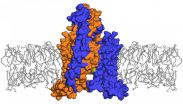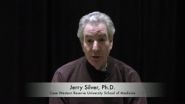(Press-News.org) Whether stubbing a toe or stroking a cat, the sensation of touch starts out as a mechanical force that is then transformed into an electrical signal conveying pain or other sensations. Tiny channels in neurons act as translators by helping to formulate that signal to the brain. However, scientists know little about the fine details of how these channels work.
New work at Rockefeller University has revealed that one such channel in humans responds to mechanical force using a never-before-seen mechanism. Researchers led by Roderick MacKinnon, John D. Rockefeller Jr. Professor and head of the Laboratory of Molecular Neurobiology and Biophysics examined the TRAAK channel, which is involved in painful touch sensation, at the molecular and atomic levels, finding that it works by reducing the flow of potassium ions that create an electrical signal. The researchers' findings were released today (December 3) in Nature.
"It is fascinating to wonder how living cells evolved molecules capable of turning small mechanical forces, such as those associated with touch, into electrical signals in the nervous system. That question served as the impetus for this work," MacKinnon says.
The channels that act as gates in the membranes that envelop neurons, including TRAAK, allow electrically charged atoms, called ions, to move in or out. It's this movement that is the basis for an electrical signal that carries information. TRAAK channels are one of 78 types of channels in the human body that transport potassium ions; there are others devoted to other ion types. By allowing potassium to trickle out of the neuron, TRAAK normally quiets the neurons, balancing out other channels, which would otherwise create a strong electrical signal for pain.
"TRAAK acts kind of like the brakes on a painful touch sensation, while other channels act as the gas. If you take away the brakes, innocuous touch becomes painful," says first author Stephen Brohawn, a postdoc in the lab.
Prior work in the lab has shown TRAAK responds to membrane tension - that is stretching caused by a physical force. However, it wasn't clear how this force caused the channel to open. In fact, scientists had previously only explained the workings of two mechanical-force sensing channels, both of which are found in bacteria.
After purifying the protein that makes up TRAAK, the team crystallized it and determined its structure using X-ray diffraction analysis. Based on the pattern produced by X-rays bounced off the crystallized protein, scientists can infer the structure of the molecule. But because it is difficult to get high-quality crystals from TRAAK, the researchers used antibodies that targeted it to create a sort of scaffold to help guide the formation of crystals.
In the structural images revealed by this work, the researchers found a unique system is responsible for holding off the flow of ions. TRAAK's central cavity, through which the ions must pass, is flanked by two spiral-shaped chains called helices. When both of these chains are kinked upward, the channel is open so potassium can leave the cell. But when one of these two chains relaxes downward, it uncovers a sort of side door into the center of the neuron membrane.
Neuron membranes, like all cell membranes, consist of two layers of molecules called lipids that have heads facing outward and greasy chains extending inward. When TRAAK's side door is open, one of those greasy chains, called an acyl chain, pokes into TRAAK's central cavity, blocking it so no potassium can pass. No known channel uses a mechanism like this.
"This is the first time anyone has seen, at a molecular level, how mechanical force can open a channel in animals, including humans," Brohawn says. "When the membrane stretches, TRAAK widens, sort of like a dot on a balloon that expands as it is inflated. That wider conformation pulls the helices upward, preventing an acyl chain from blocking the channel, and so leaving it open for potassium ions."
"The direct involvement of lipid molecules in the gating mechanism begins to explain another well-known property of TRAAK channels - that their gating is sensitive to general anesthetics and other molecules known to enter the lipid membrane where they insert themselves between its acyl chains. By doing so, it appears these anesthetics can shut down pain sensations by locking TRAAK in an open position," MacKinnon says.
INFORMATION:
A team of biomedical engineers at Washington University in St. Louis, led by Lihong Wang, PhD, the Gene K. Beare Distinguished Professor of Biomedical Engineering, has developed the world's fastest receive-only 2-D camera, a device that can capture events up to 100 billion frames per second.
That's orders of magnitude faster than any current receive-only ultrafast imaging techniques, which are limited by on-chip storage and electronic readout speed to operations of about 10 million frames per second.
Using the Washington University technique, called compressed ultrafast ...
VIDEO:
NIH-funded scientists developed a promising new drug that may lead to spinal cord injury treatments.
Click here for more information.
Injections of a new drug may partially relieve paralyzing spinal cord injuries, based on indications from a study in rats, which was partly funded by the National Institutes of Health
The results demonstrate how fundamental laboratory research may lead to new therapies.
"We're very excited at the possibility that millions of people ...
Case Western Reserve scientists have developed a new chemical compound that shows extraordinary promise in restoring function lost to spinal cord injury. The compound, which the researchers dubbed intracellular sigma peptide (ISP), allowed paralyzed muscles to activate in more than 80 percent of the animals tested. The remarkable study, partly funded by the National Institutes of Health, appears in the December 3 edition of the journal Nature.
Case Western Reserve University School of Medicine Professor of Neurosciences Jerry Silver, PhD, the senior author, led an international ...
Pilots are trained to guard against vertigo: a sudden loss of the sense of vertical direction that renders them unable to tell "up" from "down" and sometimes even leads to crashes. Coming up out of a subway station can produce similar confusion: For a few moments, you are unsure which way to go, until regaining your sense of direction. In both cases, the disorientation is thought to be caused by a temporary malfunction of a brain circuit that operates as a three-dimensional (3D) compass.
Weizmann Institute scientists have now for the first time demonstrated the existence ...
Extensive areas of the world's deltas -- which accommodate major cities such as Shanghai, Dhaka and Bangkok -- will be drowned in the next century by rising sea levels, according to a Comment piece in this week's Nature. In the article, Dr. Liviu Giosan, a geologist with the Woods Hole Oceanographic Institution (WHOI), and colleagues call for maintenance efforts to be started now to avert the loss of vast expanses of coastline, and the consequent losses of ecological services, economic and social crises, and large-scale migrations.
Problems start upstream: deltas are built ...
HOUSTON - (Dec. 3, 2014) - A novel mechanism - similar to how normal tissue stem cells respond to wounding - might explain why bladder cancer stem cells actively contribute to chemo-resistance after multiple cycles of chemotherapy drug treatment. Targeting this "wound response" of cancer stem cells can potentially provide a novel approach for therapeutic invention, said researchers from the National Cancer Institute-designated Dan L. Duncan Cancer Center at Baylor College of Medicine.
The results of their study appear online in the journal Nature today.
"Treatment ...
LA JOLLA, CA--December 3, 2014--A team led by biologists at The Scripps Research Institute (TSRI) has solved a long-standing mystery in neuroscience by identifying the "mechanoreceptor" protein that mediates the sense of touch in mammals.
Mice that lack the Piezo2 ion-channel protein in their skin cells and nerve endings lose nearly all their sensitivity to ordinary light touch, but retain a mostly normal sensitivity to painful mechanical stimuli.
"We can say with certainty that Piezo2 is the principal touch sensor in mammals," said Ardem Patapoutian, professor at TSRI ...
Researchers from the African Genome Variation Project (AGVP) have published the first attempt to comprehensively characterise genetic diversity across Sub-Saharan Africa. The study of the world's most genetically diverse region will provide an invaluable resource for medical researchers and provides insights into population movements over thousands of years of African history. These findings appear in the journal Nature.
"Although many studies have focused on studying genetic risk factors for disease in European populations, this is an understudied area in Africa," says ...
ROSEMONT, Ill.--Compression fractures in the spine due to osteoporosis, a common condition causing progressive bone loss and increased fracture risk, are especially common in older women. A new study appearing in the December 3rd issue of the Journal of Bone & Joint Surgery (JBJS) found that patients who wore a brace as treatment for a spinal compression fracture had comparable outcomes in terms of pain, function and healing when compared to patients who did not wear a brace.
Nearly 700,000 men and women suffer from a spinal compression fracture each year. These fractures, ...
People who work around the clock could actually be setting themselves back, according to Virginia Tech biologists.
Researchers found that a protein responsible for regulating the body's sleep cycle, or circadian rhythm, also protects the body from developing sporadic forms of cancers.
"The protein, known as human period 2, has impaired function in the cell when environmental factors, including sleep cycle disruption, are altered," said Carla Finkielstein, an associate professor of biological sciences in the College of Science, Fralin Life Science Institute affiliate, ...



